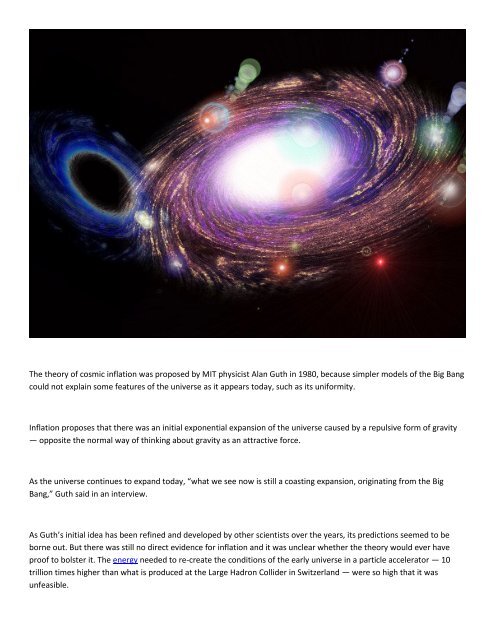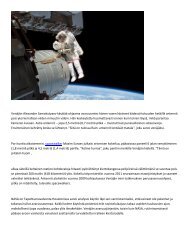Koyal Group Info Mag - A new look at the Big Bang, moments later
Scientists hailed the finding as a transformative event that will provide deep and complicated questions for physicists to explore as well as transfix the imagination of the broader public, because it gives insight into a foundational question in physics: How did the universe begin?
Scientists hailed the finding as a transformative event that will provide deep and complicated questions for physicists to explore as well as transfix the imagination of the broader public, because it gives insight into a foundational question in physics: How did the universe begin?
You also want an ePaper? Increase the reach of your titles
YUMPU automatically turns print PDFs into web optimized ePapers that Google loves.
The <strong>the</strong>ory of cosmic infl<strong>at</strong>ion was proposed by MIT physicist Alan Guth in 1980, because simpler models of <strong>the</strong> <strong>Big</strong> <strong>Bang</strong><br />
could not explain some fe<strong>at</strong>ures of <strong>the</strong> universe as it appears today, such as its uniformity.<br />
Infl<strong>at</strong>ion proposes th<strong>at</strong> <strong>the</strong>re was an initial exponential expansion of <strong>the</strong> universe caused by a repulsive form of gravity<br />
— opposite <strong>the</strong> normal way of thinking about gravity as an <strong>at</strong>tractive force.<br />
As <strong>the</strong> universe continues to expand today, “wh<strong>at</strong> we see now is still a coasting expansion, origin<strong>at</strong>ing from <strong>the</strong> <strong>Big</strong><br />
<strong>Bang</strong>,” Guth said in an interview.<br />
As Guth’s initial idea has been refined and developed by o<strong>the</strong>r scientists over <strong>the</strong> years, its predictions seemed to be<br />
borne out. But <strong>the</strong>re was still no direct evidence for infl<strong>at</strong>ion and it was unclear whe<strong>the</strong>r <strong>the</strong> <strong>the</strong>ory would ever have<br />
proof to bolster it. The energy needed to re-cre<strong>at</strong>e <strong>the</strong> conditions of <strong>the</strong> early universe in a particle acceler<strong>at</strong>or — 10<br />
trillion times higher than wh<strong>at</strong> is produced <strong>at</strong> <strong>the</strong> Large Hadron Collider in Switzerland — were so high th<strong>at</strong> it was<br />
unfeasible.
The Harvard-led team took a different approach. One prediction of <strong>the</strong> <strong>the</strong>ory is th<strong>at</strong> <strong>the</strong> rapid expansion would have<br />
left behind a fingerprint — a particular p<strong>at</strong>tern of polarized light in <strong>the</strong> cosmic microwave background. This faint light all<br />
across <strong>the</strong> sky is <strong>the</strong> afterglow of <strong>the</strong> <strong>Big</strong> <strong>Bang</strong>, emitted 380,000 years after <strong>the</strong> explosion, and <strong>the</strong> telltale p<strong>at</strong>tern was<br />
cre<strong>at</strong>ed when <strong>the</strong> light interacted with gravit<strong>at</strong>ional waves.<br />
Using a telescope called BICEP2 <strong>at</strong> <strong>the</strong> South Pole, <strong>the</strong> team claims to have detected th<strong>at</strong> swirly polariz<strong>at</strong>ion p<strong>at</strong>tern,<br />
called B-mode polariz<strong>at</strong>ion. If confirmed by o<strong>the</strong>r experiments, it will be strong evidence of infl<strong>at</strong>ion and help guide<br />
scientists to which particular version of infl<strong>at</strong>ion is <strong>the</strong> correct one.




